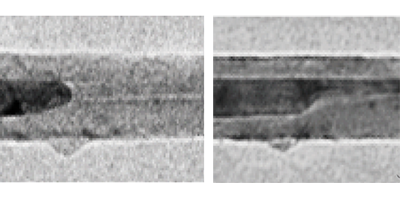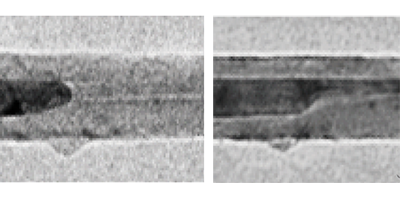Crystals Reform to Squeeze through Nanotubes
Freeing a clogged pipe often requires breaking up the obstruction. Something similar may happen at the nanoscale when a metal nanocrystal gets stuck inside a carbon nanotube. Researchers have found that iron crystals—driven through a nanotube under the influence of an electric current—will reform atom-by-atom to fit through a constriction that is tighter than the crystal itself. This anticlogging behavior, described in Physical Review Letters, could open up new possibilities in nanomachines, such as actuators with complex geometries.
Over the last decade, several experiments have demonstrated the electrically induced motion of metal crystals through carbon nanotubes. When current flows along the tube length, electron scattering causes the tiny “slugs” to move in the same direction as the electron flow. Previous studies of this electromigration have dealt primarily with smooth, uniform nanotubes. For their experiments, Sinisa Coh and colleagues from the University of California, Berkeley, and Lawrence Berkeley National Laboratory selected nanotubes containing constrictions, where the width narrowed to about nanometers.
When current was applied to the tubes, iron crystals with widths of roughly nanometers managed to pass through the tight passages. Images from a high-resolution transmission electron microscope showed that the crystals make the fit by changing shape, but there’s no melting or lattice compression (as verified with electron diffraction measurements). The authors formulated a model in which iron atoms diffuse off the back end of the crystal and then migrate along the outer surface to the front end where they reassemble within the confines of the narrow tube. Because this surface-atom motion depends on the type of atom, it could be used to remove, say, slower-migrating contaminants from the crystal. – Michael Schirber





